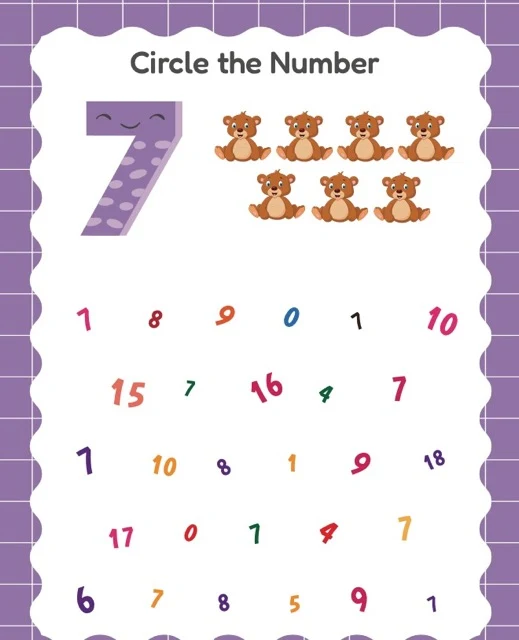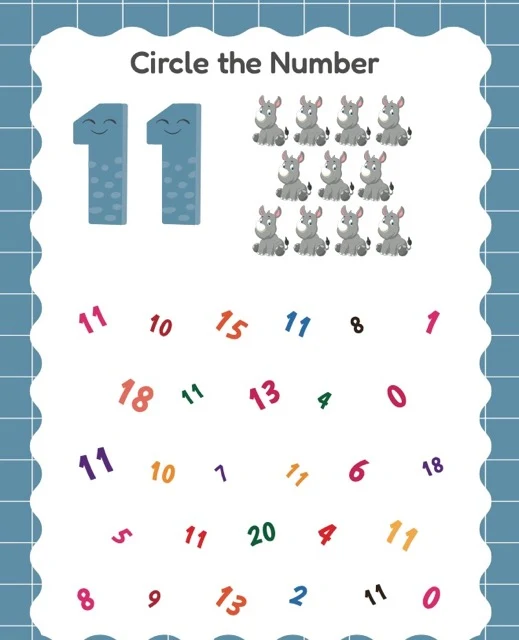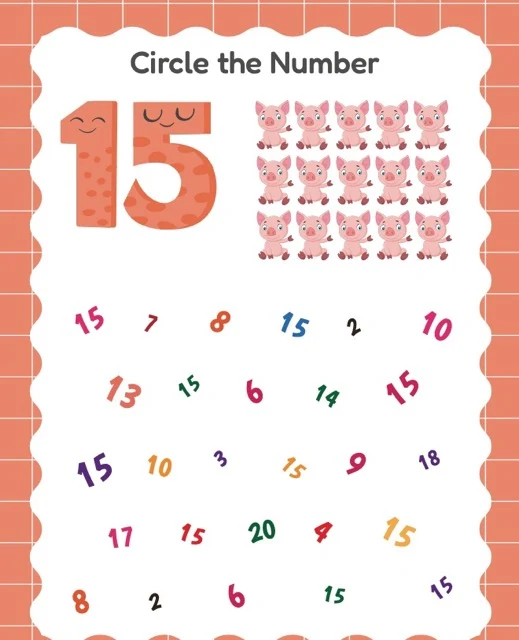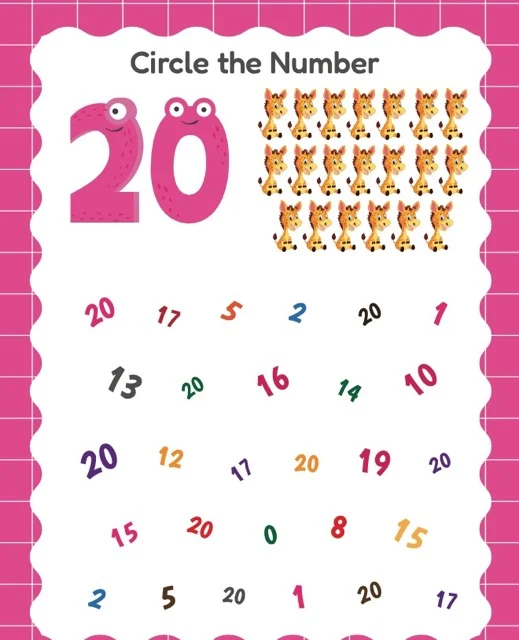Circle the Numbers: An Educational Activity
The document describes "Circle the Numbers," an educational activity designed to help young children learn number recognition and counting. Key benefits include improved number identification, counting skills, focus, and fine motor control. The activity is adaptable to various learning styles and can be modified with timers, color-coding, or themed grids to increase engagement. Its impact is significant, fostering enjoyment of learning, reinforcing fundamental math concepts, and providing a sense of accomplishment, even potentially aiding those with learning differences.Circle the Numbers Activity Guide
Briefing Doc: Circle the Numbers Activity
Overview
"Circle the Numbers" is a simple yet engaging educational activity primarily aimed at young children learning number recognition and counting. Participants are presented with grids containing various numbers and symbols and are tasked with locating and circling all instances of a specific target number on each page.
Key Educational Benefits
●
Number Recognition: The activity reinforces the ability to quickly identify and distinguish different numerals.
●
Counting Skills: Circling all instances of a target number helps children practice and solidify their counting skills.
●
Focus & Concentration: The task demands sustained attention to detail, promoting focus and concentration skills.
●
Fine Motor Skills: The act of circling numbers neatly helps refine fine motor control crucial for writing and other activities.
Adaptability & Variations
The activity caters to diverse learning styles:
●
Visual Learners: Benefit from the clear visual layout of numbers within the grids.
●
Kinesthetic Learners: Engage through the physical action of circling and potential use of tactile writing tools.
●
Auditory Learners: Can be accommodated by calling out target numbers for participants to find.
The activity can be further modified to enhance learning and engagement:
●
Timing: Introducing time limits encourages speed and accuracy.
●
Color Coding: Assigning different colors to different numbers adds complexity and visual appeal.
●
Thematic Grids: Creating grids based on themes like animals or holidays enhances relevance and interest.
Impact & Long-Term Benefits
●
Makes Learning Fun: The engaging format presents learning numbers as enjoyable rather than daunting.
●
Reinforces Basic Concepts: Provides a hands-on approach to solidify fundamental number recognition and counting skills.
●
Sense of Achievement: Completing each page instills a sense of accomplishment, motivating further learning.
●
Potential Therapeutic Tool: May benefit individuals with attention deficits or learning disabilities by promoting focus and concentration.
Quotes from Sources
●
Purpose: "The primary purpose of the "Circle the Numbers" activity is to help individuals, primarily young children, practice number recognition and counting skills in an engaging and fun way." (Circle the Numbers Activity Guide, Answer Key)
●
Adaptability: "Yes, the activity can be adapted to suit different learning styles...You can also incorporate auditory elements by calling out the numbers for participants to find." (Circle the Numbers Activity Guide, FAQ)
●
Benefits: "Successfully completing each page gives participants a sense of accomplishment and motivates them to continue learning." (Circle the Numbers Activity Guide, FAQ)
Conclusion
"Circle the Numbers" is a valuable educational tool with a simple premise and wide-ranging benefits. Its adaptability to different learning styles, potential for customization, and capacity to make learning fun make it a highly effective activity for developing essential early math skills.
Circle the Numbers Activity Guide
Circle the Numbers FAQ
What is "Circle the Numbers"?
"Circle the Numbers" is a simple yet engaging activity designed to help individuals practice number recognition and counting skills. Participants are presented with a grid filled with various numbers and symbols. The goal is to locate and circle all instances of a specific number on each page.
Who is this activity for?
This activity is primarily beneficial for young children who are learning to identify and count numbers. However, it can also be enjoyed by individuals of all ages as a fun and relaxing brain exercise.
What skills does this activity help develop?
This activity helps develop several important skills:
●
Number recognition: Participants learn to quickly identify and distinguish different numbers.
●
Counting: Circling all instances of a specific number reinforces counting skills.
●
Focus and concentration: The activity requires participants to pay close attention and focus on finding all the target numbers.
●
Fine motor skills: Circling the numbers neatly helps develop fine motor control.
How do I use the "Circle the Numbers" pages?
The pages can be printed out and used as worksheets. Provide the participant with a pencil or marker to circle the target numbers. You can start with easier pages featuring smaller numbers and gradually progress to more challenging pages with larger numbers.
What are some variations to the activity?
To add variety and challenge, you can:
●
Time the activity: Encourage participants to complete each page as quickly as possible.
●
Use different colors: Assign different colors to different numbers and have participants circle them accordingly.
●
Create your own grids: Customize the activity by creating your own grids with specific numbers or themes.
What are the benefits of incorporating this activity into learning?
●
Makes learning fun: The engaging format of the activity makes learning numbers enjoyable and less daunting.
●
Reinforces basic concepts: It effectively reinforces number recognition and counting skills in a hands-on way.
●
Provides a sense of achievement: Successfully completing each page gives participants a sense of accomplishment and motivates them to continue learning.
Can this activity be adapted for different learning styles?
Yes, the activity can be adapted to suit different learning styles. For visual learners, the visual layout of the numbers is helpful. For kinesthetic learners, the act of circling the numbers provides a tactile element. You can also incorporate auditory elements by calling out the numbers for participants to find.
Where can I find more "Circle the Numbers" pages?
You can find various "Circle the Numbers" pages online or in educational workbooks. Many websites offer free printable worksheets, allowing you to easily access and use this activity for learning and fun.
Circle the Numbers Activity Guide
"Circle the Numbers" Activity Study Guide
Short-Answer Quiz
Instructions: Answer the following questions in 2-3 sentences each.
1.
What is the primary purpose of the "Circle the Numbers" activity?
2.
Identify three skills that the "Circle the Numbers" activity helps to develop.
3.
Describe two ways the "Circle the Numbers" activity can be adapted for different learning styles.
4.
How can the activity be modified to introduce a competitive element?
5.
What is the significance of the varying number of target numbers on each page of the activity?
6.
Beyond young children, who else might benefit from participating in this activity?
7.
Explain how the "Circle the Numbers" activity provides a sense of achievement.
8.
Besides printed worksheets, where else can you find resources for the "Circle the Numbers" activity?
9.
Suggest a thematic variation for creating a customized "Circle the Numbers" grid.
10.
How does the activity's visual layout contribute to its effectiveness?
Answer Key
1.
The primary purpose of the "Circle the Numbers" activity is to help individuals, primarily young children, practice number recognition and counting skills in an engaging and fun way.
2.
The "Circle the Numbers" activity helps develop number recognition, counting skills, focus and concentration, and fine motor skills.
3.
The activity can be adapted for visual learners through its visual layout and for kinesthetic learners by providing a tactile element through circling. Auditory learners can benefit from having the numbers called out.
4.
A competitive element can be introduced by timing the activity and encouraging participants to complete each page as quickly as possible.
5.
The varying number of target numbers on each page allows for gradual progression in difficulty, starting with fewer numbers and increasing as the participant's skills develop.
6.
Individuals of all ages can benefit from the "Circle the Numbers" activity as a relaxing brain exercise that promotes focus and concentration.
7.
Successfully completing each page, with all target numbers correctly circled, gives participants a sense of accomplishment and motivates them to continue learning and improving their skills.
8.
Besides printed worksheets, "Circle the Numbers" resources can be found online through websites offering free printable worksheets and in educational workbooks.
9.
A thematic variation could involve creating a grid with numbers related to a specific topic, such as animals, sports, or holidays.
10.
The clear and organized visual layout of the numbers in the grid makes them easy to identify and distinguish, aiding in number recognition and supporting visual learners.
Essay Questions
1.
Analyze how the "Circle the Numbers" activity effectively caters to different learning styles, providing specific examples for each style.
2.
Discuss the long-term benefits of incorporating the "Circle the Numbers" activity into early childhood education, considering its impact on cognitive development and future learning.
3.
Evaluate the potential of the "Circle the Numbers" activity as a therapeutic tool for individuals with attention deficits or learning disabilities, exploring its strengths and limitations.
4.
Compare and contrast the "Circle the Numbers" activity with other number recognition and counting activities, highlighting its unique features and advantages.
5.
Design a comprehensive lesson plan incorporating the "Circle the Numbers" activity, specifying learning objectives, materials, procedures, and assessment methods.
Glossary of Key Terms
●
Number Recognition: The ability to identify and distinguish different numerals.
●
Counting Skills: The ability to enumerate objects accurately and understand numerical sequences.
●
Focus and Concentration: The ability to direct and sustain attention on a specific task or stimulus.
●
Fine Motor Skills: The coordination of small muscles in the hands and fingers, essential for precise movements like writing and drawing.
●
Visual Learners: Individuals who learn best through visual aids, images, and spatial understanding.
●
Kinesthetic Learners: Individuals who learn best through physical activity, hands-on experiences, and movement.
●
Auditory Learners: Individuals who learn best through listening, verbal instructions, and sound-based information.
●
Grid: A network of horizontal and vertical lines forming squares or cells, used in the "Circle the Numbers" activity to arrange the numerals.
●
Target Numbers: The specific numerals that participants need to locate and circle on each page of the activity.
●
Thematic Variation: Adapting the activity to incorporate specific themes or topics, such as animals, sports, or holidays, to enhance engagement and relevance.




















